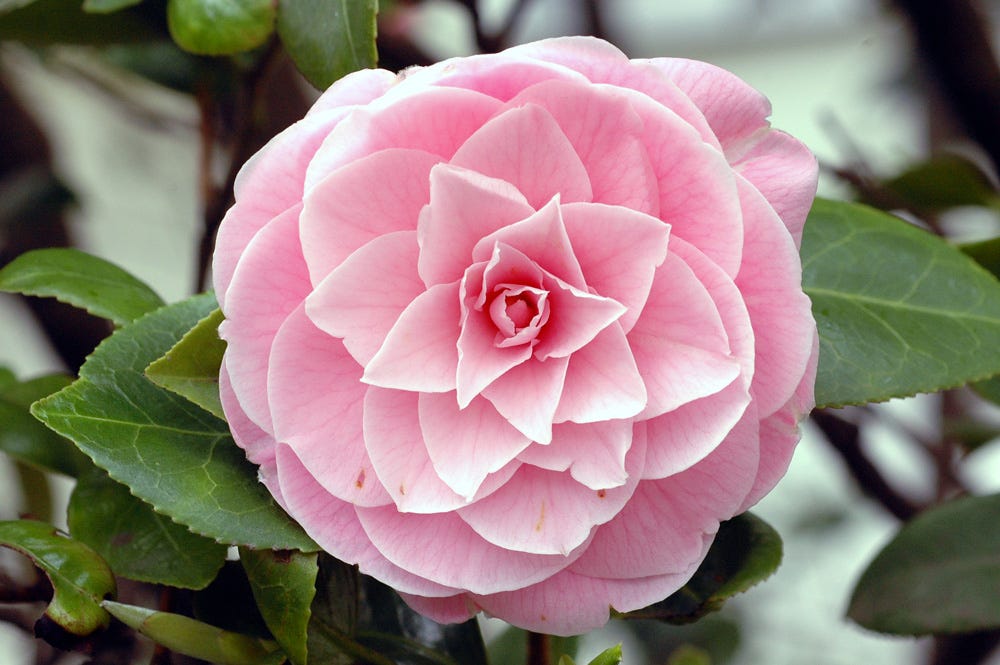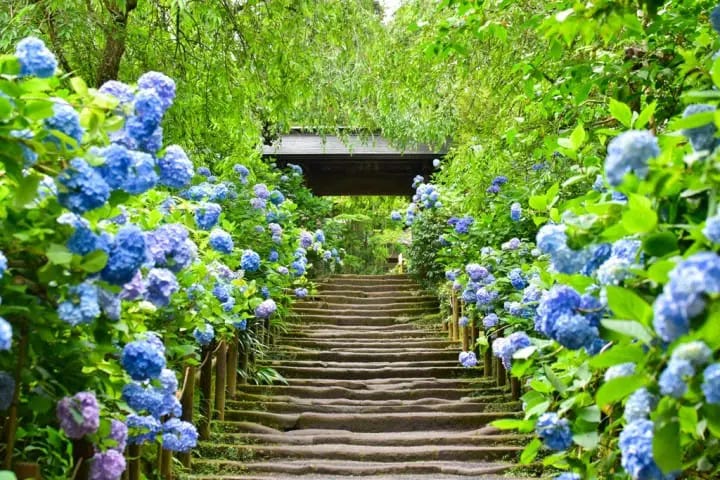When do tsubaki flowers bloom?
In what seasons does the tsubaki plant put out its astonishingly beautiful red and pink flowers?
Hint: tsubaki is written 椿. So doh. It’s in the spring (春)! Most varieties bloom in March and April.
But hey, that’s weird! They’re putting the season in which a flower blooms right into the kanji? Actually there's some serious cleverness happening here. At first glance, the 春 part at the right is phonetic, bringing with it the shun sound, which ended up as today’s Japanese on reading of chin for this character. You may know this reading from the name 椿山荘/chinzansо̄, the name of a hotel in Bunkyo-ku in Tokyo, with a world-class attached Japanese garden running down the hillside to the banks of the Kanda River. Tsubaki have grown there for centuries. The name tsubaki-yama for that area is said to date back to the 1400s, and none other than Matsuo Basho lived in a hut overlooking the area a few hundred years later. A leading Meiji period politician built a house there which is said to have been the site of many important meetings, including some with Emperor Meiji himself!
But back to the character structure. What the imaginative Chinese inventor of this character did, however, was to find a right-hand side which both conveyed the phonetics and something important about this tree—namely that it bloomed in the spring. (The tree radical on the left indicates, of course, tree-ness, although the tsubaki would normally be called a shrub, typically 15-20ft high.) In other words, the right side does double duty, related both to sound and meaning: Actually, that character originally referred to a slightly different botanical variety native to China. The Japanese adopted the character for their own tsubaki.
The origin of the word “tsubaki” is disputed. It might come from つや葉木 (tsuya-ba-ki, the tree with glossy leaves), or maybe it was 強葉木 (tsuyo-ba-ki, the tree with strong leaves), or 厚葉木 (atsu-ba-ki, with the leading a elided, the tree with thick leaves).
Tsubaki grow everywhere in Japan, both wild and cultivated. They love to grow near the ocean (Izu Oshima is well known for its tsubaki). They grow in dense groves, called 薮椿 (yabu-tsubaki; this 薮 is your character of the day!).
Feel free to send tsubaki flowers to your beloved as a show of eternal devotion (after studying up on the right shade for different flavors of passion and longing), but don’t send them to people in the hospital. That is because when the flower dies, instead of falling petal by petal, the entire head falls off. That is not considered auspicious for sick people. No graves either.
The tsubaki has held an honored position in Japanese culture for thousands of years. References can be found in the Nihon Shoki, the Tale of Genji, and the Manyoshu. Here’s one citation from volume 20 of the latter:
わが門《かど》の 片山椿まこと汝《なれ》
わが手触れなな土に落ちもかもOh tsubaki flowering on the sloping path to our gate,
Without my touch would you fall to the earth?
(Bob’s translation)
Before you ask, yes, the tsubaki here is a symbol of the travelling poet’s wife waiting all alone at home.
Seeds and Oil
You may not have known that tsubaki has seeds, about the size of a golf ball. Cold-pressing these seeds yields tsubaki oil, or in Japanese 椿油, tsubaki-abura. This remarkable oil has a wide range of uses. Its chemical composition makes it great for hair care. In the Edo period, street vendors would sell the oil, and end up in long gabbing sessions with their female clientele, leading to the expression 油を売る/abura wo uru, lit. “selling oil”, meaning to neglect one’s work for idle chit-chat. This oil can also used in cooking, and Japanese chefs oil their knives with it. Its essential nutrients and acids also make it a great skin treatment. Sufferers from male pattern baldness may be interested in its hair growth properties. The leaves also have medicinal properties. Even the bark is useful; it is ground down to make purple dye.
Names
椿 is used as a surname, albeit somewhat rare. It has also been used as a first name for both boys and girls, with different spellings. Perhaps you remember MIKI Tsubaki (三木つばき), the snowboarder at the 2022 Tokyo Olympics? If you decide to use this kanji for your next girl, why not mix things up and specify a pronunciation/reading of カメリア/Camellia if the ward office will let you?
Camellia is the English name for this plant. I had never seen or heard of this plant until I came to Japan. Perhaps that’s just because I didn’t pay very much attention to plants at all. In general, it seems fair to say that Japanese culture values plants and knowledge about them more than Western culture. For instance, the first ajisai (hydrangea) I ever saw in my life was in Japan, most likely at the lovely Ajisai-dera in Kita-Kamakura (visit in June).
I’m so happy that in getting to know Japan and Japanese I have also come to better know the natural world around me and appreciate its beauty.






